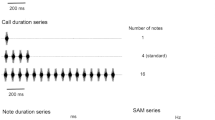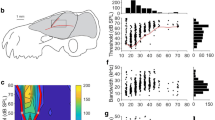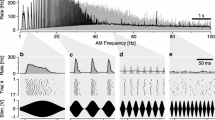Summary
-
1.
A single and multiunit survey was made of the tuning properties of auditory neurons in the rostral midbrain and caudal thalamus of the northern leopard frog,Rana p. pipiens. Lesions of the recording sites revealed auditory neurons were located in the rostrolateral torus semicircularis, pretectal gray, pretectal central gray, optic tectum, and posterocentral and posterolateral thalamic nuclei.
-
2.
Single unit analysis of 36 auditory neurons revealed that 10 responded only to specific tone combinations, or responded to single low frequency tones at high intensities (typically greater than 90 dB SPL) but their excitatory thresholds could be decreased as much as 40 dB with the addition of specific tones. All such neurons were similar in that they preferred combinations of low (<600 Hz) and high (>1,200 Hz) frequency tones. They were inhibited or not excited by intermediate frequency tones.
-
3.
The majority of neurons responded to single tones and their excitatory thresholds were not decreased by multiple tone stimulation. They were typically broadly tuned, and in some cases displayed bimodal or trimodal excitatory tuning curves. Some could be inhibited by high intensity tones near the center of their excitatory frequency range. Others were totally unresponsive to these intermediate frequencies, resulting in two discontinuous excitatory tuning curves.
-
4.
The multiunit survey at 26 recording sites examined responses to various single and multiple tone stimuli composed of 300, 750 and 1,750 Hz tones representing the low, mid and high frequency ranges of the three receptor populations. There was considerable variation in the relative excitatory capacities of these stimuli between recording sites. The trend which emerged was that (1) tone combinations were more effective than single tones, (2) combining tones often produced a non-linear summation of the responses to individual tones, (3) the 300+1,750 Hz stimulus (i.e., the low and high frequency combination) was always among the most excitatory stimuli, and (4) the addition of mid frequency tones often reduced the excitatory capacity of a stimulus.
-
5.
A previous evoked potential study of the caudal thalamus (Mudry et al. 1977) reported a non-linear summation of the potential when frequencies within the response ranges of the amphibian (low and mid frequencies) and basilar papillae (high frequencies) were combined. Present single and multiunit analyses extend these results, and suggest that these regions of the anuran auditory system show a particular preference for tone combinations which approximate the spectral energy distribution of the species mating call.
Similar content being viewed by others
Abbreviations
- BEF :
-
best excitatory frequency
- ETC :
-
excitatory tuning curve
- ISI :
-
interstimulus interval
- ITC :
-
inhibitory tuning curves
- METC :
-
multiple tone excitatory tuning curve
- MTR :
-
multiple tone responder
- STR :
-
single tone responder
- TTI :
-
two tone inhibition
References
Capranica RR (1965) The evoked vocal response of the bull-frog: A study of communication by sound. Res Mongr 33. MIT Press, Cambridge (Massachusetts)
Comer C, Grobstein P (1981) Organization of sensory inputs to the midbrain of the frog,Rana pipiens. J Comp Physiol 142:161–169
Feng AS (1975) Sound localization in anurans: an electrophysiological and behavioral study. Ph D thesis, Cornell University, Ithaca (New York)
Feng AS, Capranica RR (1976) Sound localization in anurans.I. Evidence of binaural interaction in the dorsal medullary nucleus of bullfrogs (Rana catesbeiana). J Neurophysiol 39:871–881
Feng AS, Shofner WP (1981) Peripheral basis of sound localization in anurans: Acoustic properties of the frog's ear. Hearing Res 5:201–216
Feng AS, Narins PM, Capranica RR (1975) Three populations of primary auditory fibers in the bullfrog (Rana catesbeiana): Their peripheral origins and frequency sensitivities. J Comp Physiol 100:221–229
Feng AS, Gerhardt HC, Capranica RR (1976) Sound localization behavior of the green treefrog (Hyla cinerea) and the barking treefrog (H. gratiosa). J Comp Physiol 107:241–252
Frishkopf LS, Goldstein MH (1963) Responses to acoustic stimuli from single units in the eighth nerve of the bullfrog. J Acoust Soc Am 35:1219–1228
Frishkopf LS, Capranica RR, Goldstein MH (1968) Neural coding in the bullfrog's auditory system — a teleological approach. Proc IEEE 56:969–980
Fuzessery ZM (1982) Frequency selectivity in the anuran auditory system: Neural correlates of the discrimination of the species mating call. Ph D thesis, University of Illinois, Urbana (Illinois)
Fuzessery ZM, Feng AS (1981) Frequency representation in the dorsal medullary nucleus of the leopard frog,Rana p. pipiens. J Comp Physiol 143:339–347
Fuzessery ZM, Feng AS (1982) Frequency selectivity in the anuran auditory midbrain: Single unit responses to single and multiple tone stimulation. J Comp Physiol 146:471–484
Fuzessery ZM, Feng AS (1983) Frequency selectivity in the anuran medulla: Excitatory and inhibitory tuning properties of single neurons in the dorsal medullary and superior olivary nuclei. J Comp Physiol 150:107–119
Gerhardt HC (1974) The significance of some spectral features in mating call recognition in the green treefrog (Hyla cinerea). J Exp Biol 61:229–241
Kruse KC (1981) Phonotactic responses of female northern leopard frogs (Rana pipiens) toR. blairi, a presumed hybrid, and conspecific calls. J Herpetol 15:145–151
Mecham JS (1971) Vocalizations of the leopard frog,Rana pipiens, and three related Mexican species. Copeia 3:505–515
Moffat AJM, Capranica RR (1974) Sensory processing in the peripheral auditory system of treefrogs (Hyla). J Acoust Soc Am 55:480
Mudry KM, Constantine-Paton M, Capranica RR (1977) Auditory sensitivity of the diencephalon of the leopard frog,Rana p. pipiens. J Comp Physiol 114:1–13
Narins PM, Capranica RR (1980) Neural adaptations for processing the two-note call of the Puerto Rican treefrog,Eleutherodactylus coqui. Brain Behav Evol 17:48–66
Neary TJ (1974) Diencephalic efferents of the torus semicircularis in the bullfrog,Rana catesbeiana. Anat Rec 178:425
Potter HD (1965a) Patterns of acoustically evoked discharges of neurons in the mesencephalon of the bullfrog. J Neurophysiol 28:1155–1184
Potter HD (1965b) Mesencephalic auditory region of the bullfrog. J Neurophysiol 28:1132–1154
Scalia F (1976) The optic pathway of the frog: Nuclear organization and connections. In: Llinás R, Precht W (eds) Frog neurobiology. Springer, Berlin Heidelberg New York, pp 386–404
Scheich H (1977) Central processing of complex sounds and feature analysis. In: Bullock TH (ed) Recognition of complex acoustic signals. Life sciences res, rep 5. Dahlem Konferenzen, Berlin
Trachenberg MC, Ingle D (1974) Thalamo-tectal projections in the frog. Brain Res 79:419–430
Walkowiak W (1980) The coding of auditory signals in the torus semicircularis of the fire-bellied toad and the grass frog: Responses to simple stimuli and to conspecific calls. J Comp Physiol 138:141–148
Wilczynski W (1981) Afferents to the midbrain auditory center in the bullfrog,Rana catesbeiana. J Comp Neurol 198:421–433
Author information
Authors and Affiliations
Rights and permissions
About this article
Cite this article
Fuzessery, Z.M., Feng, A.S. Mating call selectivity in the thalamus and midbrain of the leopard frog (Rana p. pipiens): Single and multiunit analyses. J. Comp. Physiol. 150, 333–344 (1983). https://doi.org/10.1007/BF00605023
Accepted:
Issue Date:
DOI: https://doi.org/10.1007/BF00605023




